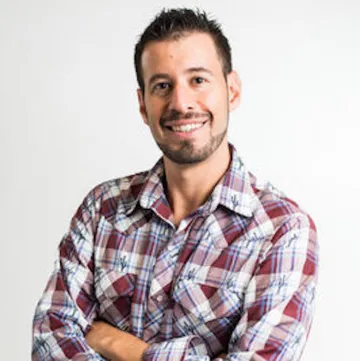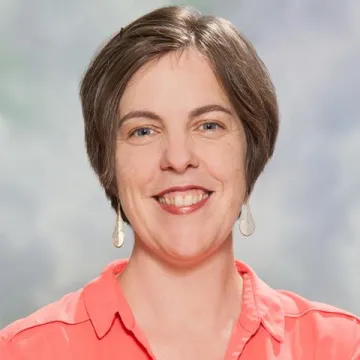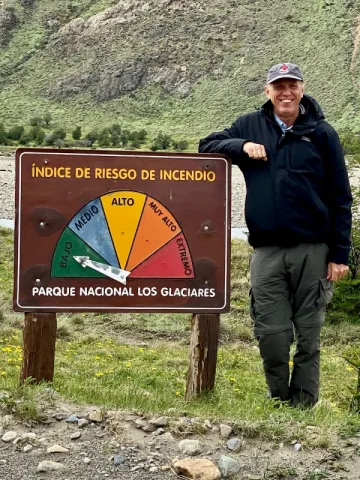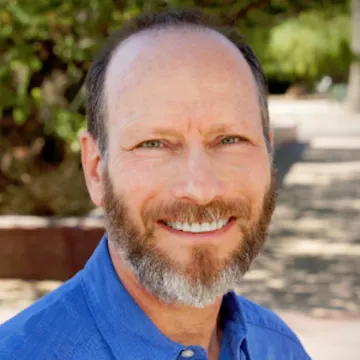Fire and the Future:
Tucson’s Bighorn Fire One Year Later
Image by Frankie Lopez (Unsplash.com)
A public engagement webinar by the Arizona Institute for Resilience (AIR), premiered on June 2, 2021.
In June and July 2020, Tucsonans watched as a lightning-caused fire swept across the Santa Catalina Mountains, a rolling inferno that engulfed most of the range. By July 23—the official containment date—the Bighorn Fire had burned 119,978 acres, from upland desert along the Front Range to the pine forests at 8,500 feet. The Arizona Institutes for Resilience (AIR) three-part webinar “Fire on the Mountain” in August 2020 looked at the fire in depth to help us better understand what transpired.
A year later, we are starting to find answers to some of the most critical questions of 2020, as well as to look to the future: What was the role of invasive plant species in the behavior of the fire, especially at the wildland-urban interface? What studies are being undertaken to understand the changing role of fire in increasingly vulnerable landscapes? Climate change is our new reality, what are the short- and long-term trends for weather extremes and their effects on species not just in the Southwest but on a continental scale? What are the key governance and policy issues from the local to the national level?
This free public webinar by AIR and the University of Arizona brought the expertise of our community to address the evolving and expanding role of fire in the west. Watch the episode to better understand not only the fire itself but the complex interactions between climate change, invasive species, management practices, policy, and economics that are shaping our future.
Want to learn more?
Check out the resources for the community on wildfires, their effects, and how you can get involved!
Watch the episode
To view our three Fire on the Mountain episodes that aired in August 2020, please visit our archived webpage.
Fire and the Future Panelists
Bios in the order of appearance

Ben's research is broadly focused in desert ecology, botany, and biogeography. He utilizes multiple approaches and time scales to establish baselines to better understand modern biodiversity and connect science to conservation. Ben has served as Director of the Desert Laboratory on Tumamoc Hill since October 2016, is Interim Director of CAZMEX, the Consortium for Arizona-Mexico Arid Environments, and co-founder and director of the Next Generation Sonoran Desert Researchers (N-Gen). He received his PhD in Botany from the University of California, Riverside under the guidance of Dr. Exequiel Ezcurra for his dissertation research, "Historical Biogeography of the Midriff Islands, Gulf of California." and returned to his hometown of Tucson, Arizona after two years as a Visiting Scholar in the lab of Dr. Rodolfo Dirzo at Stanford University focusing on ecological education for Indigenous communities. Ben's efforts incorporate diverse perspectives and strives to create opportunities for collaboration across borders and disciplines and a more holistic understanding and appreciation for the Sonoran Desert.

Dr. Betancourt is scientist emeritus with the National Research Program, Water Mission Area, USGS, and an Adjunct Professor at the University of Arizona, where he was co-located as a federal scientist for 30 years. He is a broadly-trained geoscientist and ecologist focused on how climate affects terrestrial ecosystems on spatial and temporal scales critical for physical and biological processes. A main objective of his studies is to establish baselines for detecting and forecasting change, and for developing rational approaches to managing water and other natural resources under an uncertain and changing climate. Dr. Betancourt integrates diverse methods, including paleo studies, long-term monitoring, and analyses of the instrumental record to study and understand the history, rates, dynamics and causes of climate, hydrological and ecosystem change at annual to millennial time scales.

Elizabeth Baldwin researches environmental, energy and water policy in the U.S. and internationally. She is broadly interested the role that non-state actors play in implementing natural resource policies, the way that laws and legal rules structure stakeholder involvement, and the degree to which such stakeholder involvement affects policy outcomes. One of her current research projects examines ways that private sector and non-profit organizations affect U.S. state energy efficiency and renewable energy policies. She also has an ongoing research project evaluating the use and governance of off-grid and decentralized energy systems in sub-Saharan African countries.

Emily Fulé is a current Master's student in the School of Natural Resources and the Environment at the University of Arizona. She graduated with a BA in Geography from Macalester College in Saint Paul, MN in 2017 and worked as a field biologist at Saguaro National Park from 2017 to 2020.

Rebecca Beers is a recent graduate from the Northern Arizona University geology master's program, where she focused on post-wildfire geomorphology in the southeastern Arizona Sky Islands. In March 2021, Rebecca joined the Arizona Geological Survey and is primarily working on post-wildfire research with Dr. Ann Youberg.

Don Falk’s research focuses on fire history, fire ecology, and the adaptation of restoration ecology to resilience in a changing world. He is a Fellow of the American Association for the Advancement of Science (AAAS), and has received a Fulbright Short-Term Scholar award, the Ecological Society of America’s Deevey Award, and the Udall Faculty Fellowship in Public Policy. He is the author of more than 150 publications, including five edited books: Genetics and Conservation of Rare Plants, Foundations of Restoration Ecology (now in Second Edition) and The Landscape Ecology of Fire. Don was a delegate to the 2015 UN climate summit in Paris and leads the University of Arizona’s undergraduate degree program in Global Change Ecology and Management. Don holds degrees from Oberlin College, Tufts University, and the University of Arizona. Don was co-founder and Executive Director of the Center for Plant Conservation, originally at Arnold Arboretum of Harvard University and now at San Diego Zoo Global; he then served as the first Executive Director of the Society for Ecological Restoration.

Dr. Tim Brown is a Research Professor and conducts applied research and applications development at the Desert Research Institute (DRI) in Reno, Nevada. His primary academic interests include wildland fire-climate and fire-weather connections; the wildfire environment; applications development for wildland fire management planning, decision-making and policy; the interface between science and decision-making; and user engagement through the deliberate co-production of knowledge. Dr. Brown is Director of the Western Regional Climate Center, and established and directs the Program for Climate, Ecosystem and Fire Applications (CEFA) at DRI. He is graduate faculty in the Atmospheric Sciences Program at the University of Nevada, Reno, and quandom Adjunct at the Monash University School of Earth, Atmosphere and Environment, Science Faculty in Clayton, Victoria, Australia.

Gregg Garfin has worked for the last 20 years to bridge the science-society interface through dialogues between scientists and decision makers and collaborative climate and environment research projects. His research focuses on adaptation to a changing climate, climate variability, and drought. Geographic interests include semi-arid regions, transboundary regions, and monsoon climates. He is co-lead author for the Southwest chapter in the Fourth National Climate Assessment. He is co-editor of Climate in Context: Science and Society Partnering for Adaptation, a 2016 book on the development and practice of use-inspired science and the co-production of science and policy, through NOAA's RISA program. His recent projects include development of a partnership to address the public health risks of extreme heat in the U.S.-Mexico border region, an assessment of National Park Service cultural resource vulnerability to climate extremes, and an investigation of best practices for assessing the costs of floods in North America. Gregg also holds many other campus affiliations, including: Director, Water, Society & Policy M.S. program; Affiliated faculty, School of Geography and Development; Affiliated faculty, Laboratory of Tree-Ring Research; Affiliated Faculty, Udall Center for Studies in Public Policy; University of Arizona representative to the National Council for Science and the Environment Leaders’ Alliance.
University of Arizona production partners
Desert Laboratory on Tumamoc Hill
Arizona Public Media
Center for Climate Adaptation Science and Solutions
Southwest Climate Adaptation Science Center
Fire and the Future Producers and Staff
Executive Producers
Benjamin Wilder, Director, Desert Laboratory on Tumamoc Hill
Roseann Hanson, Art and Science Program Coordinator, Desert Laboratory on Tumamoc Hill
Moderator
Tom McNamara, Arizona Public Media
Technical Facilitators
Maya Patterson, Arizona Institutes for Resilience
Anna Seiferle-Valencia, Program Coordinator, Desert Laboratory on Tumamoc Hill
Amanda Leinberger, Adaptation Program Manager, Center for Climate Adaptation Science and Solutions
Producers and Advisors
John Booth, Arizona Public Media
James Buizer, Arizona Institutes for Resilience
Don Falk, School of Natural Resources and the Environment
Ann Youberg, Arizona Geological Survey
Catch the recordings of the webinars about the Bighorn Fire
Watch the Fire on the Mountain: Understanding Tucson's Bighorn Fire webinar series recordings to learn about the event, the aftermath, and the future of the Santa Catalina Mountains.
Watch Fire and the Future: Tucson's Bighorn Fire One Year Later, premiered on June 2, 2021 to learn more about the effects of the fire, the studies underway, and the actions you can take.
Resources for Information and Action
- Arizona-Sonora Desert Museum’s Save Our Saguaros Project
- USA National Phenology Network's Nature's Notebook Program
- Sky Island Alliance — restoration and wildlife monitoring
- Watershed Management Group — restoration and monitoring
- Desert Bighorn Sheep Society — game surveys and conservation, including Catalinas restoration
- Arizona Game & Fish Department — bighorn sheep surveys
- Coronado National Forest, Catalinas District — volunteer opportunities
- Critical Zone National Observatory — Catalinas
- Biosphere2 — take a tour
University of Arizona
- Center for Climate Adaptation Science and Solutions (CCASS) — climate adaptation
- Climate Assessment for the Southwest (CLIMAS) — climate adaptation
- Southwest Climate Adaptation Science Center (SW CASC)
- Bridging Biodiversity and Conservation Science (BBCS) — emerging transitions needed to mitigate and adapt to climate change
- Institute for Energy Solutions (IES)
- University Climate Change Coalition (UC3)
- Office of Sustainability
City and County
- City of Tucson’s climate change, sustainability and resilience policies
- Pima County Sustainability Programs Division Sustainable Action Plan for County Operations (2018-2025)
Community
- Tucson Climate Action Network (and they're on Facebook!)
Arizona Illustrated hosted a 30-minute Bighorn Fire special in November 2020, produced by Vanessa Barchfield, including:
- Lessons from the Chiricahuas: What happens to ecosystems after a wildfire or other major disturbances?
- After the Burn: In the aftermath of the Bighorn Fire, researchers see a unique opportunity to better understand how fire impacts southern Arizona's delicate sky island ecosystems.
- Wildlife and the Bighorn: A look at some of the specific wildlife species that live in the Catalina Mountains north of Tucson and how wildfire impacts their existence.

